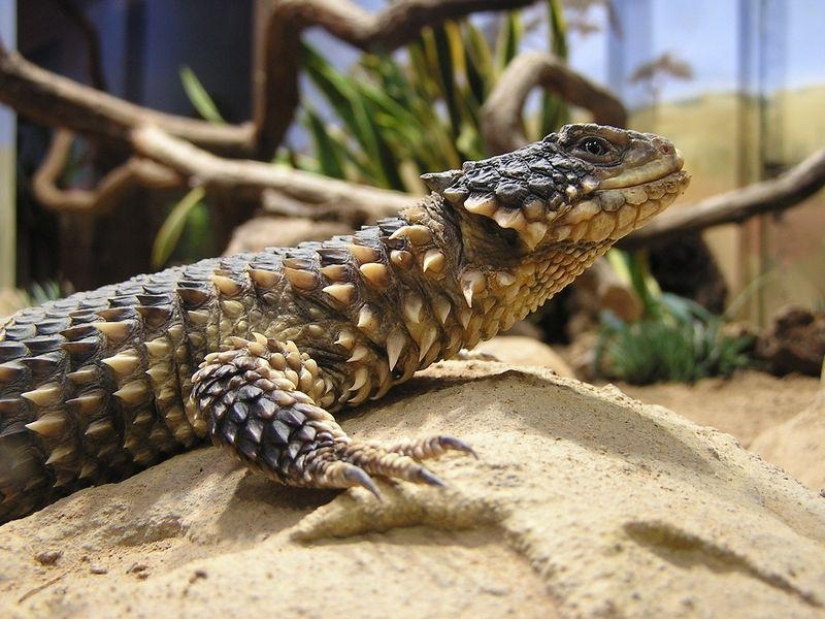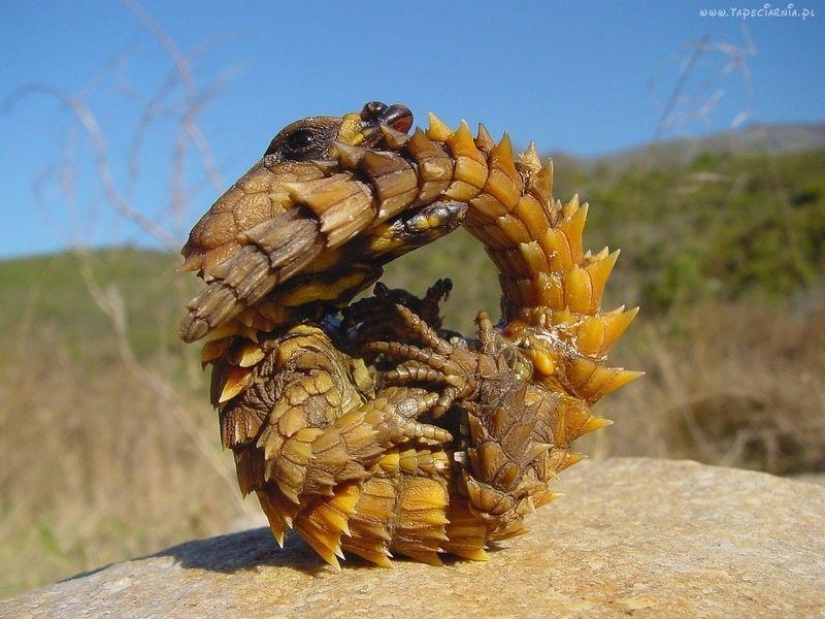Diurnal lizards - belttails
Categories: Animals
By Pictolic https://pictolic.com/article/diurnal-lizards-belttails.htmlAmazing creatures Belttails belong to the family of reptiles of the lizard suborder. The family includes about 70 species. Belttails are diurnal lizards, the size of various members of the family ranges from 12 to 70 cm.
(Total 16 photos)


1. Belttails live in the rocky and arid regions of South Africa, and are also found on the island of Madagascar. These amazing creatures live in rocky deserts and semi-deserts, bushes, savannahs, some species of belttails rise high into the mountains. Quite often, lizards live on rocky outcrops, among placers of boulders.

2. Belt tails differ from other lizards in the presence of large scales, which look like rectangular plates, which cover the bone base of the reptile. The scales are especially large on the back, on the belly it is less developed. The scales located on the tail form wide rings (girdle), thanks to which the family got its name "Girdletails".

3. The body of the belttails is colored light or dark brown, due to this coloring they are also called golden belttails. There is a dark pattern on the abdomen, which is especially pronounced in the chin area.
The teeth of the girdletails are homogeneous, pleurodont. The eyes of the girdletails are well developed, with a round pupil, the eyelids are separate and movable. Some species of belttails have well-developed five-fingered limbs. On both sides of the body of the girdletails there is a special fold, which is lined with small scales, which, like spindletails, facilitates eating, breathing and laying eggs.

4. Belttails live in groups on stony soils. Belttails are active during the daytime. Cracks in rocks, burrows, gaps between stones serve as a refuge for the belttail.

5. In times of danger, the small belttail curls up into a ball, while capturing the tip of the tail with its teeth, for which it is also called the armadillo lizard. In this way, the small belttail defends its weak spot - the abdomen. Interestingly, in this position, the small girdle of the tail cannot be separated. Some belttails, at the moment of danger, hide in the gap between the stones, cling to their claws and swell, resting against the walls of the shelter, in this way the belttails do not allow the attacker to pull them out of there.

6. Most of the members of the family are ovoviviparous lizards, but there are also oviparous species. Belttails living in the southern part of the range can hibernate, this is due to the fact that the ambient temperature is very high in summer and very low in winter. Some species of belttails, especially common in the northern part, do not hibernate in the winter season.

7. In nature, some species of belttails feed on insects, other species are completely herbivores. Larger belttails, which measure up to 70 cm in length, prey on small mammals and other lizards that are smaller than themselves.
It is almost impossible to determine the gender of the belted frog. But, as a rule, females are smaller than males, besides, females have a lighter head, which has a distinct triangular shape. Males reach sexual maturity at the age of three.

8. The life expectancy of belttails is more than 25 years. The Lesser Belttail can live 5-7 years in captivity.
All types of belttails have their own characteristics and cardinal differences. So, in some species of girdletails, all limbs are very well developed, while in others they are completely absent or are in a highly degraded state (as, for example, in chamesaurs). The nutrition of belttails also varies greatly in each individual species. Some of the representatives of the belttails feed on insects, while others are completely herbivorous. But, the largest belt-tails, whose dimensions reach seventy centimeters in length, hunt small mammals and lizards smaller than themselves for food.

9. Belttails, living in the southern regions of their distribution area, fall into hibernation, freezing during the cold season. However, there are also such species of belttails (mainly in the northern part of their distribution) that do not hibernate in the winter season. Different types of belttails have different defensive strategies. Particularly distinctive of them can be called the self-defense of the small belttail. This type of girdletail lacks hard scaly plates in the abdomen, which is why this place is the most vulnerable. Therefore, during a premonition of danger, the small girdletail curls up into a ball, biting its tail very hard - so that it cannot be separated. This is how the small belttail defends its weak spot.
The belttail genus includes the following species and subspecies:
Each genus of belttails, in turn, includes several subspecies.

10. Individuals in the group are tameable and easy to get around, despite the fact that the rest of the family will hide when trying to pick them up. Those who are prone to sociability can be tamed to eat from their hands. Males are aggressive (against the background of males of other belt-tailed species), therefore only one male is kept in the group. Belttails allow you to watch them, do not hide. Less timidity will also be facilitated by pasting the glass of the terrarium with a film, allowing you to see your pets, but they do not see you.
The East African belttail needs a spacious horizontal terrarium (90 liters for one pet, for a group - 180 liters, you can, of course, more). For example, for a group, 90 cm (width) x 60 cm (depth) x 50 cm (height) is quite suitable. This species is quite social, therefore it is recommended to keep the group. In order to make the skin changing process smoother, a bathing tub is placed in the terrarium.
For lighting, lamps with ultraviolet radiation (Repti Glo 10.0) and incandescent lamps are used, under which pets can warm themselves. Daily mode: 12-14 hour day. The temperature under the incandescent lamp should reach 35 degrees (this type loves to sunbathe), in other areas about 25. Night temperatures should be lower: 20 - 22 degrees. Humidity: 40-60%. When kept at home, East African belttails are quite omnivorous, and their diet mainly consists of crickets, mealworms, and grasshoppers. Insects are sprinkled with calcium and vitamin supplements before feeding. Feeding worms should be placed in a feeding container so that they do not accidentally mix with the substrate. Feeding frequency for adults is usually once every two to three days. If we see that our people were reluctant to eat, then sometimes we even take a break of up to 3 days. Newborns are recommended to be immediately separated from their parents. For kids, a 30x40x30 cm terrarium (for 2 individuals) is suitable. Babies are placed in 2 individuals, because with a higher density, excessive stress and mortality are observed. Babies are ready to eat a couple of hours after birth. Babies feed on the same food as adults, only in smaller volumes.

eleven.

12.

13.

14.

15.

16.
Recent articles

No wonder long hair has been considered a woman's adornment for many centuries. Girls with luxurious curls attract attention and ...

And now the artists have fans who regularly visit their concerts, stand for hours in line for a selfie or an autograph and know by ...
Related articles

We all know that allergies can be cats, dogs, chocolate, citrus fruits and pollen. But things that can cause a dangerous reaction, ...

We share a planet with many venomous snakes. They are everywhere, except for the coldest continent – Antarctica. It is quite ...

May 4-International Day of Firefighters and Rescuers remember their dead colleagues who risked their lives to save other people. ...

Sometimes a single incident can completely change a person's life, turning it into a legend whose reality is hard to believe. ...